Yingxin Lai
Agent4FaceForgery: Multi-Agent LLM Framework for Realistic Face Forgery Detection
Sep 16, 2025Abstract:Face forgery detection faces a critical challenge: a persistent gap between offline benchmarks and real-world efficacy,which we attribute to the ecological invalidity of training data.This work introduces Agent4FaceForgery to address two fundamental problems: (1) how to capture the diverse intents and iterative processes of human forgery creation, and (2) how to model the complex, often adversarial, text-image interactions that accompany forgeries in social media. To solve this,we propose a multi-agent framework where LLM-poweredagents, equipped with profile and memory modules, simulate the forgery creation process. Crucially, these agents interact in a simulated social environment to generate samples labeled for nuanced text-image consistency, moving beyond simple binary classification. An Adaptive Rejection Sampling (ARS) mechanism ensures data quality and diversity. Extensive experiments validate that the data generated by our simulationdriven approach brings significant performance gains to detectors of multiple architectures, fully demonstrating the effectiveness and value of our framework.
HCCM: Hierarchical Cross-Granularity Contrastive and Matching Learning for Natural Language-Guided Drones
Aug 29, 2025Abstract:Natural Language-Guided Drones (NLGD) provide a novel paradigm for tasks such as target matching and navigation. However, the wide field of view and complex compositional semantics in drone scenarios pose challenges for vision-language understanding. Mainstream Vision-Language Models (VLMs) emphasize global alignment while lacking fine-grained semantics, and existing hierarchical methods depend on precise entity partitioning and strict containment, limiting effectiveness in dynamic environments. To address this, we propose the Hierarchical Cross-Granularity Contrastive and Matching learning (HCCM) framework with two components: (1) Region-Global Image-Text Contrastive Learning (RG-ITC), which avoids precise scene partitioning and captures hierarchical local-to-global semantics by contrasting local visual regions with global text and vice versa; (2) Region-Global Image-Text Matching (RG-ITM), which dispenses with rigid constraints and instead evaluates local semantic consistency within global cross-modal representations, enhancing compositional reasoning. Moreover, drone text descriptions are often incomplete or ambiguous, destabilizing alignment. HCCM introduces a Momentum Contrast and Distillation (MCD) mechanism to improve robustness. Experiments on GeoText-1652 show HCCM achieves state-of-the-art Recall@1 of 28.8% (image retrieval) and 14.7% (text retrieval). On the unseen ERA dataset, HCCM demonstrates strong zero-shot generalization with 39.93% mean recall (mR), outperforming fine-tuned baselines.
DDAP: Dual-Domain Anti-Personalization against Text-to-Image Diffusion Models
Jul 29, 2024Abstract:Diffusion-based personalized visual content generation technologies have achieved significant breakthroughs, allowing for the creation of specific objects by just learning from a few reference photos. However, when misused to fabricate fake news or unsettling content targeting individuals, these technologies could cause considerable societal harm. To address this problem, current methods generate adversarial samples by adversarially maximizing the training loss, thereby disrupting the output of any personalized generation model trained with these samples. However, the existing methods fail to achieve effective defense and maintain stealthiness, as they overlook the intrinsic properties of diffusion models. In this paper, we introduce a novel Dual-Domain Anti-Personalization framework (DDAP). Specifically, we have developed Spatial Perturbation Learning (SPL) by exploiting the fixed and perturbation-sensitive nature of the image encoder in personalized generation. Subsequently, we have designed a Frequency Perturbation Learning (FPL) method that utilizes the characteristics of diffusion models in the frequency domain. The SPL disrupts the overall texture of the generated images, while the FPL focuses on image details. By alternating between these two methods, we construct the DDAP framework, effectively harnessing the strengths of both domains. To further enhance the visual quality of the adversarial samples, we design a localization module to accurately capture attentive areas while ensuring the effectiveness of the attack and avoiding unnecessary disturbances in the background. Extensive experiments on facial benchmarks have shown that the proposed DDAP enhances the disruption of personalized generation models while also maintaining high quality in adversarial samples, making it more effective in protecting privacy in practical applications.
GM-DF: Generalized Multi-Scenario Deepfake Detection
Jun 28, 2024Abstract:Existing face forgery detection usually follows the paradigm of training models in a single domain, which leads to limited generalization capacity when unseen scenarios and unknown attacks occur. In this paper, we elaborately investigate the generalization capacity of deepfake detection models when jointly trained on multiple face forgery detection datasets. We first find a rapid degradation of detection accuracy when models are directly trained on combined datasets due to the discrepancy across collection scenarios and generation methods. To address the above issue, a Generalized Multi-Scenario Deepfake Detection framework (GM-DF) is proposed to serve multiple real-world scenarios by a unified model. First, we propose a hybrid expert modeling approach for domain-specific real/forgery feature extraction. Besides, as for the commonality representation, we use CLIP to extract the common features for better aligning visual and textual features across domains. Meanwhile, we introduce a masked image reconstruction mechanism to force models to capture rich forged details. Finally, we supervise the models via a domain-aware meta-learning strategy to further enhance their generalization capacities. Specifically, we design a novel domain alignment loss to strongly align the distributions of the meta-test domains and meta-train domains. Thus, the updated models are able to represent both specific and common real/forgery features across multiple datasets. In consideration of the lack of study of multi-dataset training, we establish a new benchmark leveraging multi-source data to fairly evaluate the models' generalization capacity on unseen scenarios. Both qualitative and quantitative experiments on five datasets conducted on traditional protocols as well as the proposed benchmark demonstrate the effectiveness of our approach.
Selective Domain-Invariant Feature for Generalizable Deepfake Detection
Mar 19, 2024



Abstract:With diverse presentation forgery methods emerging continually, detecting the authenticity of images has drawn growing attention. Although existing methods have achieved impressive accuracy in training dataset detection, they still perform poorly in the unseen domain and suffer from forgery of irrelevant information such as background and identity, affecting generalizability. To solve this problem, we proposed a novel framework Selective Domain-Invariant Feature (SDIF), which reduces the sensitivity to face forgery by fusing content features and styles. Specifically, we first use a Farthest-Point Sampling (FPS) training strategy to construct a task-relevant style sample representation space for fusing with content features. Then, we propose a dynamic feature extraction module to generate features with diverse styles to improve the performance and effectiveness of the feature extractor. Finally, a domain separation strategy is used to retain domain-related features to help distinguish between real and fake faces. Both qualitative and quantitative results in existing benchmarks and proposals demonstrate the effectiveness of our approach.
SHIELD : An Evaluation Benchmark for Face Spoofing and Forgery Detection with Multimodal Large Language Models
Feb 06, 2024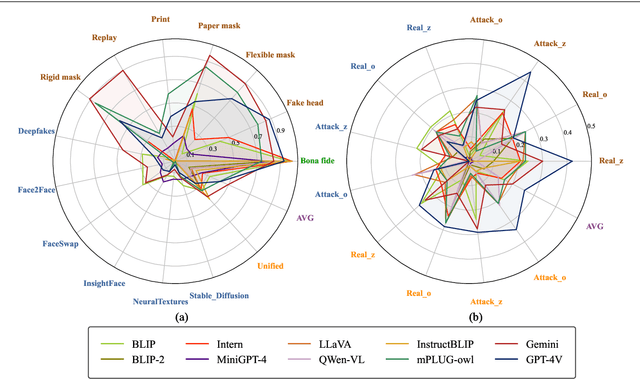
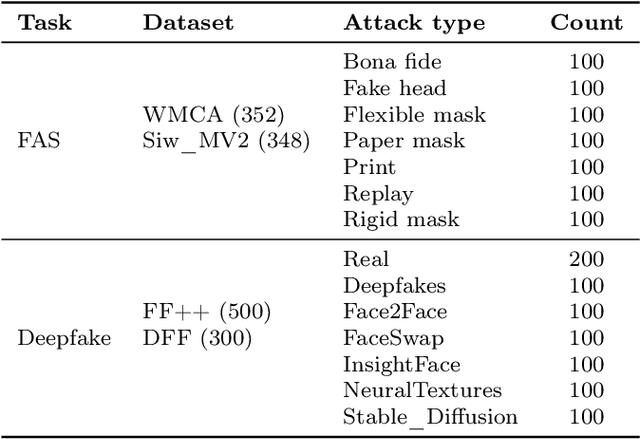
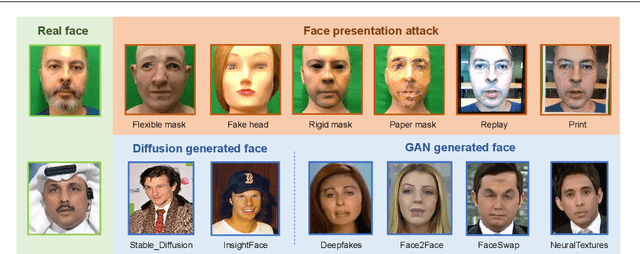
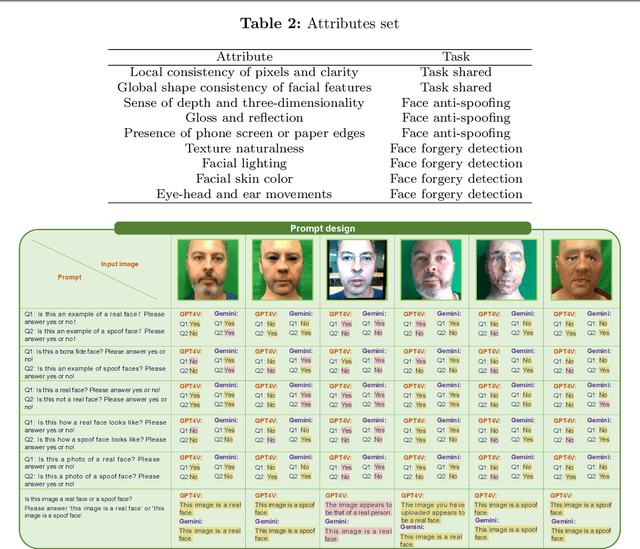
Abstract:Multimodal large language models (MLLMs) have demonstrated remarkable problem-solving capabilities in various vision fields (e.g., generic object recognition and grounding) based on strong visual semantic representation and language reasoning ability. However, whether MLLMs are sensitive to subtle visual spoof/forged clues and how they perform in the domain of face attack detection (e.g., face spoofing and forgery detection) is still unexplored. In this paper, we introduce a new benchmark, namely SHIELD, to evaluate the ability of MLLMs on face spoofing and forgery detection. Specifically, we design true/false and multiple-choice questions to evaluate multimodal face data in these two face security tasks. For the face anti-spoofing task, we evaluate three different modalities (i.e., RGB, infrared, depth) under four types of presentation attacks (i.e., print attack, replay attack, rigid mask, paper mask). For the face forgery detection task, we evaluate GAN-based and diffusion-based data with both visual and acoustic modalities. Each question is subjected to both zero-shot and few-shot tests under standard and chain of thought (COT) settings. The results indicate that MLLMs hold substantial potential in the face security domain, offering advantages over traditional specific models in terms of interpretability, multimodal flexible reasoning, and joint face spoof and forgery detection. Additionally, we develop a novel Multi-Attribute Chain of Thought (MA-COT) paradigm for describing and judging various task-specific and task-irrelevant attributes of face images, which provides rich task-related knowledge for subtle spoof/forged clue mining. Extensive experiments in separate face anti-spoofing, separate face forgery detection, and joint detection tasks demonstrate the effectiveness of the proposed MA-COT. The project is available at https$:$//github.com/laiyingxin2/SHIELD
A Multilevel Guidance-Exploration Network and Behavior-Scene Matching Method for Human Behavior Anomaly Detection
Dec 07, 2023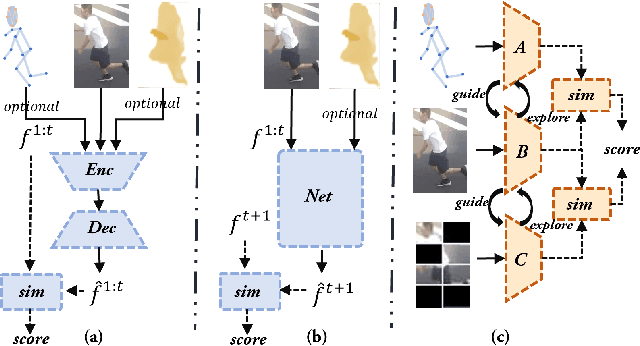
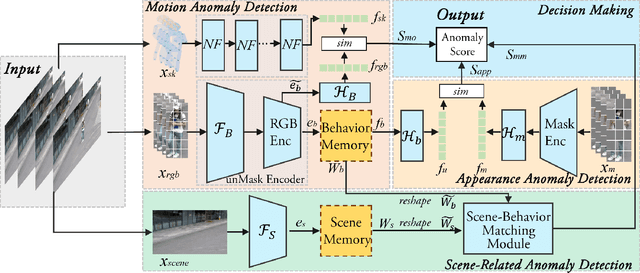
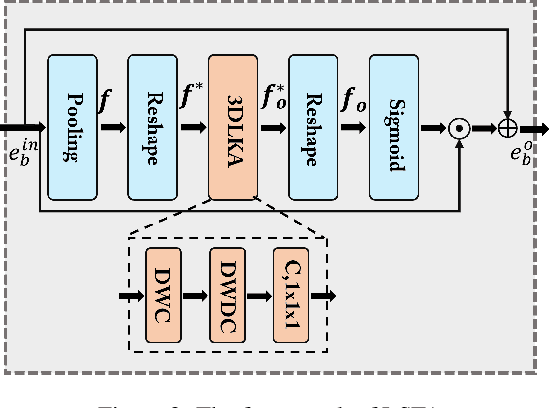

Abstract:Human behavior anomaly detection aims to identify unusual human actions, playing a crucial role in intelligent surveillance and other areas. The current mainstream methods still adopt reconstruction or future frame prediction techniques. However, reconstructing or predicting low-level pixel features easily enables the network to achieve overly strong generalization ability, allowing anomalies to be reconstructed or predicted as effectively as normal data. Different from their methods, inspired by the Student-Teacher Network, we propose a novel framework called the Multilevel Guidance-Exploration Network(MGENet), which detects anomalies through the difference in high-level representation between the Guidance and Exploration network. Specifically, we first utilize the pre-trained Normalizing Flow that takes skeletal keypoints as input to guide an RGB encoder, which takes unmasked RGB frames as input, to explore motion latent features. Then, the RGB encoder guides the mask encoder, which takes masked RGB frames as input, to explore the latent appearance feature. Additionally, we design a Behavior-Scene Matching Module(BSMM) to detect scene-related behavioral anomalies. Extensive experiments demonstrate that our proposed method achieves state-of-the-art performance on ShanghaiTech and UBnormal datasets, with AUC of 86.9 % and 73.5 %, respectively. The code will be available on https://github.com/molu-ggg/GENet.
DynamicBEV: Leveraging Dynamic Queries and Temporal Context for 3D Object Detection
Oct 07, 2023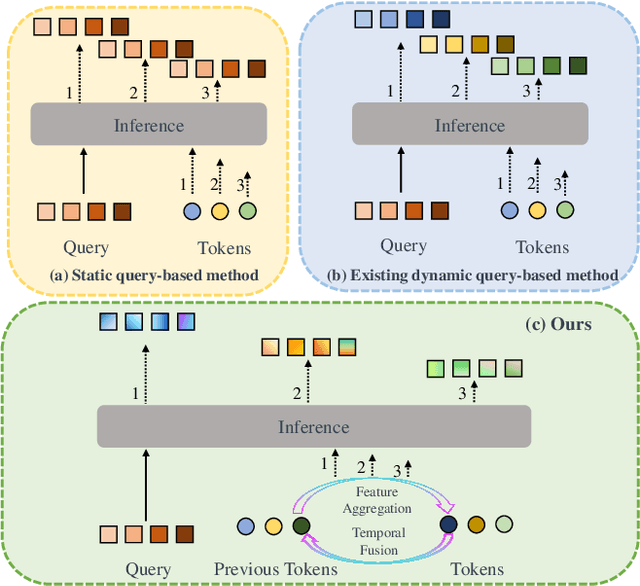

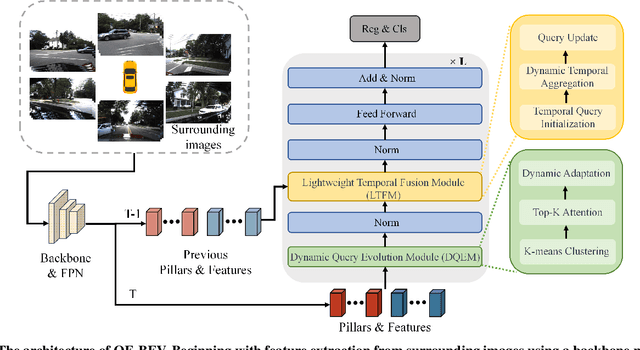
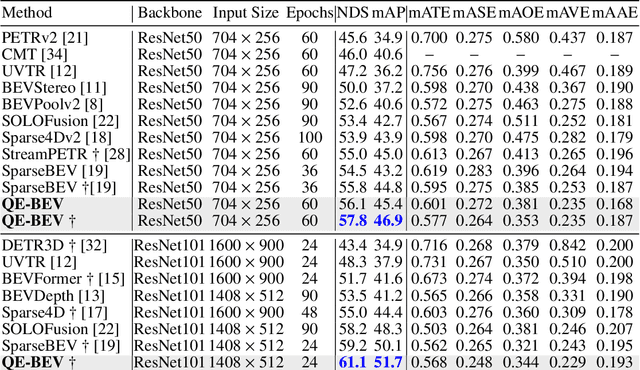
Abstract:3D object detection is crucial for applications like autonomous driving and robotics. While query-based 3D object detection for BEV (Bird's Eye View) images has seen significant advancements, most existing methods follows the paradigm of static query. Such paradigm is incapable of adapting to complex spatial-temporal relationships in the scene. To solve this problem, we introduce a new paradigm in DynamicBEV, a novel approach that employs dynamic queries for BEV-based 3D object detection. In contrast to static queries, the proposed dynamic queries exploit K-means clustering and Top-K Attention in a creative way to aggregate information more effectively from both local and distant feature, which enable DynamicBEV to adapt iteratively to complex scenes. To further boost efficiency, DynamicBEV incorporates a Lightweight Temporal Fusion Module (LTFM), designed for efficient temporal context integration with a significant computation reduction. Additionally, a custom-designed Diversity Loss ensures a balanced feature representation across scenarios. Extensive experiments on the nuScenes dataset validate the effectiveness of DynamicBEV, establishing a new state-of-the-art and heralding a paradigm-level breakthrough in query-based BEV object detection.
Detect Any Deepfakes: Segment Anything Meets Face Forgery Detection and Localization
Jun 29, 2023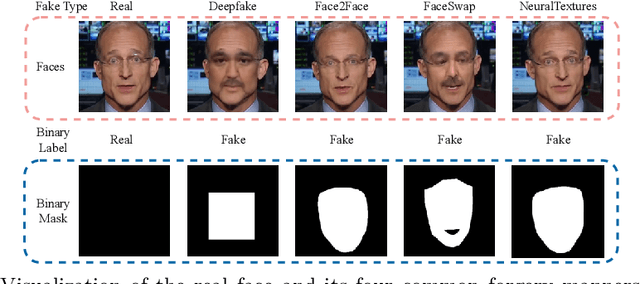
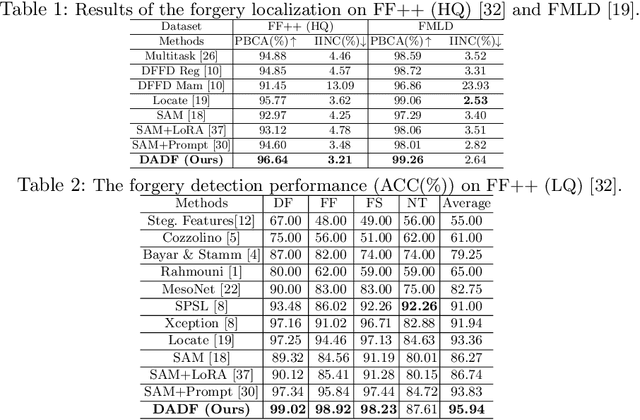
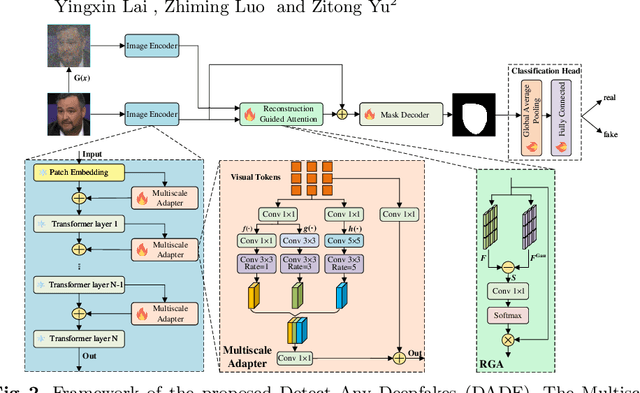

Abstract:The rapid advancements in computer vision have stimulated remarkable progress in face forgery techniques, capturing the dedicated attention of researchers committed to detecting forgeries and precisely localizing manipulated areas. Nonetheless, with limited fine-grained pixel-wise supervision labels, deepfake detection models perform unsatisfactorily on precise forgery detection and localization. To address this challenge, we introduce the well-trained vision segmentation foundation model, i.e., Segment Anything Model (SAM) in face forgery detection and localization. Based on SAM, we propose the Detect Any Deepfakes (DADF) framework with the Multiscale Adapter, which can capture short- and long-range forgery contexts for efficient fine-tuning. Moreover, to better identify forged traces and augment the model's sensitivity towards forgery regions, Reconstruction Guided Attention (RGA) module is proposed. The proposed framework seamlessly integrates end-to-end forgery localization and detection optimization. Extensive experiments on three benchmark datasets demonstrate the superiority of our approach for both forgery detection and localization. The codes will be released soon at https://github.com/laiyingxin2/DADF.
 Add to Chrome
Add to Chrome Add to Firefox
Add to Firefox Add to Edge
Add to Edge